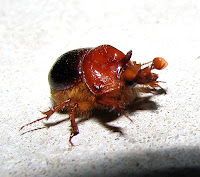Bolborhachium hollowayi
This handsome little orange/brown beetle belongs to a group of 25 mainly Australian species in the genus Bolborhachium, the majority of which occur in WA and many of these primarily along the southern coastal fringe. They are a poorly known group of largely subterranean insects whose larvae apparently feed on fungi and/or humus. The female digs a deep vertical burrow where she constructs an egg chamber that is stocked with food for the larvae.
The male of this species is a little over 1 cm (1/2”) in length and identified by the ornamentation on its head and prothorax (large shield behind the head), with each species sporting a different appendage. Bolborhachium hollowayi has a single horn, others have more and/or different shapes. The females have no appendages, which apparently can make matching the male to the female of the same species somewhat difficult.
They are supposed to be attracted to house lights at night, which is what happened to the few I have photographed, but these were no more than a small handful over several years and in the case of Bolborhachium hollowayi, has only been seen during October and March. So if these beetles are strongly attracted to house lights, then they are not common locally (20 km or 12.5 miles east of Esperance) despite Bolborhachium hollowayi being first named and collected only 35 km (22 miles) west of Esperance.
As Bolborhachium largely inhabit the coastal fringe, it might reflect a preference of these insects for alkaline habitats and so largely exclude my main observation area sited on non-calcareous soils, but bordering a calcareous zone. The alkaline environment is also more extensive in the region where was originally recorded than here.
Bolborhachium is a member of the Bolboceratidae family, although was originally placed in Geotrupidae.
My thanks to Kim Pullen of the Australian National Insect Collection, CSIRO Ecosystem Sciences who very kindly identified this species.





